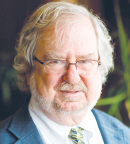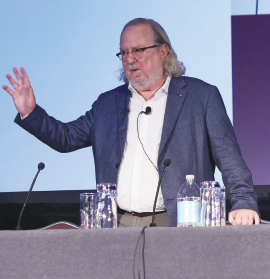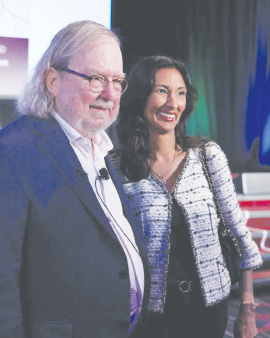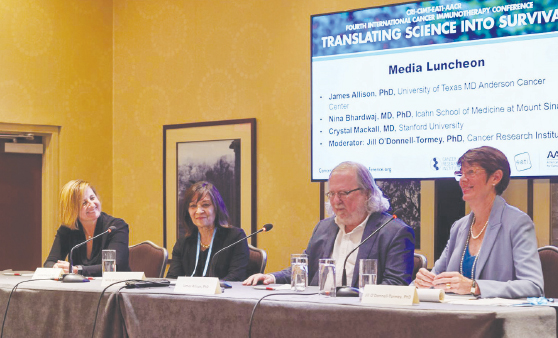
James P. Allison, PhD
Even before James P. Allison, PhD, made an appearance at the Fourth International Cancer Immunotherapy Conference: Translating Science Into Survival in New York City, the excitement among attendees was palpable. Earlier that day, October 1, 2018, Dr. Allison and Tasuku Honjo, MD, PhD, of Kyoto University in Japan, had been announced as recipients of the 2018 Nobel Prize in Physiology or Medicine. When Dr. Allison arrived at the conference to comment on the award and express his appreciation, the mood among attendees had reached a crescendo of excitement, and he was greeted with rock-star adoration by the more than 1,400 researchers and industry leaders from 32 countries present at the conference.
Dr. Allison, Chair of the Department of Immunology, Director of the Parker Institute for Cancer Research, and Executive Director of the Immunotherapy Platform at The University of Texas MD Anderson Cancer in Houston, was not originally scheduled to speak at the conference, which was cosponsored by the Cancer Research Institute (CRI), the Association for Cancer Immunotherapy, the European Academy of Tumor Immunology, and the American Association for Cancer Research (AACR). He had come to the conference to see his wife, Padmanee Sharma, MD, PhD, Professor of Genitourinary Medical Oncology and Professor in the Department of Immunology at The University of Texas MD Anderson Cancer Center, receive the William B. Coley Award for Distinguished Research in Tumor Immunology. It was pure serendipitous happenstance that the news from the Nobel Prize committee came during the conference.
“I’m glad I came [to the conference] because there are so many colleagues and friends here carrying on the good fight,” said Dr. Allison. “When I got the call from a Nobel committeeman, he said that this was in recognition of a whole new field of a way of treating cancer. I got the inspiration from the people working in the field who are trying to do good for our patients with cancer.”
Revolutionizing Cancer Care
Dr. Allison’s Nobel Prize for his work on immune checkpoint blockade in oncology comes nearly 4 decades after he identified the T-cell antigen receptor in 1982 as a young investigator during his first stay at MD Anderson. That discovery became the cornerstone of his life’s work. Six years later, as Professor at the University of California, Berkeley, Dr. Allison demonstrated that the molecule CD28 is the “gas pedal” that T cells need for activation.
In 1994, Dr. Allison and another investigator, Jeffrey Bluestone, PhD [now President and Chief Executive Officer of the Parker Institute for Cancer Immunotherapy and the A.W. and Mary -Margaret Clausen Distinguished Professor of Metabolism and Endocrinology at the University of California, San Francisco], identified cytotoxic T-lymphocyte–associated protein 4 (CTLA-4) as an inhibitory checkpoint molecule. Dr. Allison then proposed that blocking CTLA-4 would enhance activation of T-cell responses against cancer, which it did.

“I got the inspiration from the people working in the field who are trying to do good for our cancer patients. I wish you all the best,” Nobel Laureate James P. Allison, PhD, told the audience at the Fourth International Cancer Immunotherapy Conference. Photo Credit: CRI-CIMT-EATI-AACR International Cancer Immunotherapy Conference/Maeghan Donohue.
In 1996, Dr. Allison published murine studies of an antibody he developed against CTLA-4, which found that 90% of the cancers in the treated mice disappeared. His discovery led to the development of ipilimumab (Yervoy), the first of a new class of drugs known as immune checkpoint inhibitors, and forged a paradigm shift in immunotherapy research. In 2011, after a large randomized phase III trial of ipilimumab in patients with advanced melanoma showed a survival benefit—the first drug ever to do so—the U.S. Food and Drug Administration (FDA) approved ipilimumab in the treatment of metastatic melanoma.
Ipilimumab is now approved alone or in combination with other immunotherapeutics for the treatment of certain types of colorectal cancer, melanoma, and renal cell carcinoma. Its development has subsequently led to the FDA approval of six other checkpoint inhibitors, which target programmed cell death protein 1 (PD-1). The PD-1 protein was discovered, in 1992, by Dr. Allison’s co-winner of the Nobel Prize in Physiology or Medicine, Dr. Honjo.
‘New Principle for Cancer Therapy’
Although understanding how T cells recognized and defended against foreign cells invading the immune system—not curing cancer—was Dr. Allison’s original goal, today, immunotherapy is widely accepted as the fourth pillar of cancer care, following surgery, radiation therapy, and chemotherapy.
“By stimulating the inherent ability of our immune system to attack tumor cells, this year’s Nobel Laureates have established an entirely new principle for cancer therapy,” noted the Nobel Assembly at Karolinska Institute in Stockholm, which is responsible for selecting the Nobel Laureates in Physiology or Medicine, in a press release announcing the award.
In addition to the Nobel Prize, which will be presented to Dr. Allison on December 10, 2018, in Stockholm, Sweden, he was recently awarded the 2018 Albany Medical Center Prize in Medicine and Biomedical Research. In 2013, Science magazine named cancer immunotherapy its Breakthrough of the Year, citing Dr. Allison’s work as crucial to immunotherapy’s rapid advancement. That year, he also received the inaugural AACR-CRI Lloyd J. Old Award in Cancer Immunology and the Breakthrough Prize in Life Sciences. Dr. Allison has also been the recipient of the Lasker-DeBakey Clinical Medical Research Award and the first Tang Prize for Biopharmaceutical Science, for opening “a new therapeutic era in medicine.”
Understanding the Mechanisms of Cancer
“Jim [Allison] is a dyed-in-the-wool immunologist who never set out to hope to cure cancer, but rather just understand how T cells worked,” said Jill O’Donnell-Tormey, PhD, Chief Executive Officer and Director of Scientific Affairs at the CRI, during a press briefing at the conference. “When Jim discovered CTLA-4, nobody thought immunotherapy was going to become the fourth pillar of how you treat cancer, and certainly pharmaceutical companies were not interested in touching immunotherapy. It was Jim’s persistence that got at least some pharmaceutical companies to be interested in [immunotherapy] and take it on and show that you can take a basic [science] discovery into clinics that can benefit patients.”
The ASCO Post caught up with Dr. Allison 2 days after he received the call from Stockholm confirming he had been awarded the Nobel Prize in Physiology or Medicine to talk about how the award might impact his research and how the power of scientific perseverance will result in more cancer cures.
First, congratulations on being awarded the Nobel Prize and recognized for your decades-long pioneering research in cancer immunotherapy. What does this award mean to you?
I’m still digesting the news. First of all, it is the pinnacle of recognition for scientific achievement. I think it’s the dream of many scientists to receive this award. I hope it informs a lot of people that there are curative cancer treatments now and that the knowledge will bring optimism to patients with cancer. I also hope they will be motivated not only to use the immunotherapies that are already FDA approved
As a scientist, I tell my students all the time, no experiment is a bad experiment if you learned something, even if you didn’t get the answer you wanted.— James P. Allison, PhD
Tweet this quote
to treat their cancer, but also to participate in clinical trials. We need to relay to patients that we are willing to take a risk and try new treatment combinations to improve cancer outcomes.
I have been involved in a lot of clinical trials looking at the changes that occur in cancer in terms of immunologic components and how that would allow us to get a higher fraction of patients touched by cancer to respond to immunotherapy. Right now, the combination of anti–CTLA-4 and PD-1 blockade immunotherapy in metastatic melanoma achieves about 60% of objective responses. It would be great to get that number as close to 100% as possible and then get comparable responses in other difficult-to-treat cancers, such as glioblastoma and pancreatic cancer. We need to start working on that, and I’m hoping that all the public attention and recognition from the Nobel Prize will make it easier to launch these sorts of studies.
Encouraging Patients to Participate in Clinical Trials
Are you planning to change your research focus because of the Nobel Prize?
Not in any fundamental way. My research is in two parts. One is in my own basic science laboratory, where we are still looking at other potential checkpoint inhibitors, how they work in combination in mice models, and detailed mechanisms of response. The other part of my research is with Dr. Sharma in the immunotherapy platform at MD Anderson, where we currently have over 100 clinical trials with different agents. We have obtained institutional review board approval to collect tissue and blood samples across multiple tumor types for immune monitoring analysis to get a better understanding of these cancers and to generate hypotheses to take back to the lab; then we can test them in mice and generate additional hypotheses from those studies and confirm them or prove them wrong.
If I could change anything that is fundamental to research it would be the hope that more patients participate in clinical trials and that more funding comes along to further new research.
Achieving More Cancer Cures
What is the future for immune checkpoint therapies in oncology, especially in the advanced-care setting? Is there a possibility of curing more cancers or converting more cancers to chronic diseases?
I think more cancers will become curable. I do understand that using the words “cure and cancer” in the same sentence has been verboten for a long time. But having met some patients who are 10, 14, and 18 years out from their cancer diagnosis after a single round of treatment with an anti–CTLA-4 checkpoint inhibitor, telling them they have a chronic disease, and not a cure, is not very satisfying. I know one female patient who was told by her oncologist not to become pregnant because there was a chance her cancer could recur. She said, “I’m going to have kids and live my life and not look over my shoulder and worry about cancer every day.”

James P. Allison, PhD, and his wife, Padmanee Sharma, MD, PhD. At the conference, Dr. Sharma received the William B. Coley Award for Distinguished Research in Tumor Immunology (page 45). Photo Credit: CRI-CIMT-EATI-AACR International Cancer Immunotherapy Conference/Maeghan Donohue.
I don’t know what the time limit is of being in remission before you can say a patient is cured. You can’t tell newly diagnosed patients when they start treatment that they will be cured of their cancer—that would be misleading. But after being disease-free for 5 years, maybe we can consider that a cure. The survival rate is certainly different now for patients with advanced melanoma. About 22% of patients with melanoma who remain in remission for 3 years and are still alive at 10 years are basically “cured” and will die of something other than melanoma. And that is just with ipilimumab treatment alone; we know that when you combine the therapy with a PD-1 inhibitor, the 3-year survival response is about 50%. Will those patients live 10 years and beyond? I would venture to say “yes.”
We have to wait and see what happens, but immunotherapy combinations are being used more frequently in clinical trials of many types of cancer, including kidney, bladder, lung, breast, cervical, and colorectal cancers. We will soon know more about their effectiveness in these other cancers.

“When Jim discovered CTLA-4, nobody thought immunotherapy was going to become the fourth pillar of how you treat cancer,” said Jill O’Donnell-Tormey, PhD, Chief Executive Officer and Director of Scientific Affairs at the Cancer Research Institute ( far right), during a press briefing at the Fourth International Cancer Immunotherapy Conference. With Dr. O’Donnell-Tormey, from left to right, are Crystal Mackall, MD, conference scientific planning committee member; Nina Bhardwaj, MD, PhD, conference co-chair; and James P. Allison, PhD. Photo Credit: CRI-CIMT-EATI-AACR International Cancer Immunotherapy Conference/Maeghan Donohue.
Almost certainly for the more difficult cancers such as pancreatic cancer and glioblastoma, we are going to need to bring in other treatment modalities, including chemotherapy and radiation therapy. We have the opportunity now to get a more detailed landscape of these cancers using new analytic techniques such as high-dimensional flow-cytometry data analysis, which did not exist 4 years ago.
If you test an immunotherapy agent that did not meet its clinical endpoint, that may not mean the agent is inactive. It may mean you need to study samples from treated patients to determine whether other immunologic pathways should be targeted in a combination strategy before you can elicit clinical responses. We have to learn the mechanism behind why those agents failed. And those sorts of studies are just beginning.
As a scientist, I tell my students all the time, no experiment is a bad experiment if you learned something, even if you didn’t get the answer you wanted.
Building on Incremental Success
What words of encouragement would you give to young investigators, especially those who may be frustrated with funding challenges and the slow pace of progress?
Funding challenges are difficult to deal with. One of the advantages of receiving the Nobel Prize and other awards is the outlet they provide to speak out about the importance of research. Students need to be persistent and submit multiple grant applications as well as persevere and follow their data in the lab.
My research in CTLA-4 is a good example of how scientific perseverance pays off.— James P. Allison, PhD
Tweet this quote
I tell my students to pick an area of research and look at the data their studies generate to figure out what they are telling you, not just whether the information is consistent with their research hypothesis. See what can be learned from the information and just keep going on and not worry about the potential clinical impacts down the road.
By definition, research success is incremental: you have to build on what you learn and take the information one or two steps farther. By paying attention to the fundamental mechanisms of the research, there is a chance of making a quantum leap. My research in CTLA-4 is a good example of how scientific perseverance pays off. ■
DISCLOSURE: Dr. Allison has stock or other ownership in Jounce, Neon, BioAtla, Forty-Seven, Apricity, Polaris, Marker Therapeutics, and Codiak; and he has consulted or advised Jounce, Kite Pharma, Neon, Amgen, Forty-Seven, Apricity, Polaris, Marker Therapeutics, and Codiak.

